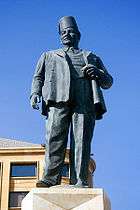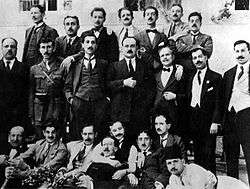Riad Al Solh
| Riad El Solh رياض الصلح | |
|---|---|
 | |
| Prime Minister of Lebanon | |
|
In office 25 September 1943 – 10 January 1945 | |
| President | Bishara Al Khouri |
| Preceded by | Office established |
| Succeeded by | Abdul Hamid Karami |
|
In office 14 December 1946 – 14 February 1951 | |
| President | Bishara Al Khouri |
| Preceded by | Saadi Al Munla |
| Succeeded by | Hussein Al Oweini |
| Personal details | |
| Born |
1894 Sidon, Ottoman Empire |
| Died |
July 17, 1951 (aged 56-57) Amman, Jordan |
| Political party |
Committee of Union and Progress (1916–1920) Independent (1920–1934) Constitutional Bloc (1934–1951) |
| Spouse(s) | Fayza Al Jabiri |
| Children |
Five daughters: Leila Al Solh, 'Alia Alsulh, Bahija Alsulh, Lamia Alsulh, Muna Alsulh; One son |
| Alma mater | Sorbonne University |
| Profession | Lawyer |
| Religion | Sunni Islam |
Riad Al Solh (1894 – 17 July 1951) (Arabic: رياض الصلح) was the first prime minister of Lebanon after the country's independence.[1][2]
Biography
Early life
Riad Al Solh, also written Riad el Solh or Riad Solh, was born in Sidon in 1894.[1] His family was a prominent Sunni land-owning family from south Lebanon, Sidon.[3][4] His father was Reda Al Solh, a reformist sub-governor in Nabatiyyah and in Saida and a leading nationalist Arab leader.[5] Reda Al Solh was tried by Ottoman forces in 1915 and went into exile in Smyrna, Ottoman Empire.[5] He then served as an Ottoman governor in Salonica.[5] He also served as Minister of the Interior in Emir Faisal’s government in Damascus.[6]
Riad Al Solh studied law and political science at the University of Paris.[1] He spent most of his youth in Istanbul, as his father was a deputy in the Ottoman Parliament.[6]
Career

Solh served as prime minister of Lebanon twice. His first term was just after the Lebanon's independence (25 September 1943 – 10 January 1945).[7] Solh was chosen by president Bishara Al Khouri to be his first Prime Minister.[8] Solh and Khouri achieved and implemented the National Pact (al Mithaq al Watani) in November 1943 that provided an official framework to accommodate the confessional differences in Lebanon.[9][10][11] The National Pact was an unwritten gentleman's agreement.[12] The Pact stated that president, prime minister and Speaker of the Parliament in Lebanon should be allocated to three major confessional groups based on the 1932 census, namely the Maronite Christians, the Sunni Muslims and the Shiite Muslims, respectively.[12] During his first term, Solh also served as the minister of supplies and reserves from 3 July 1944 to 9 January 1945.[13]
Solh held premiership again from 14 December 1946 to 14 February 1951[14] again under the presidency of Bishara Al Khouri.[15] Solh was critical of King Abdullah and played a significant role in granting the blessing of the Arab League's political committee to the All-Palestine Government during his second term.[16]
Assassination
Solh escaped unhurt an assassination attempt in March 1950.[5][17] It was perpetrated by a member of the Syrian Social Nationalist Party.[5]
However, several months after leaving office, he was gunned down on 17 July 1951 at Marka Airport in Amman by the members of the Syrian Social Nationalist Party.[3][14] The attack was perpetrated by three gunmen, who killed him in revenge for the execution of Anton Saadeh, one of the party's founding leaders.[18][19][20]
Personal life
Al Solh was married to Fayza Al Jabri, the sister of two-time prime minister of Syria, Saadallah al-Jabiri.[21] They had five daughters and a son, Reda, who died in infancy.[5] His eldest daughter, Aliya (1935–2007), continued in her father's path in the struggle for a free and secure Lebanon. Aliya propagated the rich cultural heritage of Lebanon abroad until her death in Paris.
Lamia Al Solh (born 1937) is married to the late Prince Moulay Abdallah of Morocco, King Mohammed VI's uncle.[22] Her children are Moulay Hicham, Moulay Ismail and a daughter Lalla Zineb.
Mona Al Solh was formerly married to the Saudi Prince Talal bin Abdulaziz.[23][24] She is the mother of the Prince Al Waleed bin Talal, Prince Khalid bin Talal and Princess Reema bint Talal.[23][25]
Bahija Al Solh Assad is married to Said Al Assad who is the former Lebanese ambassador to Switzerland and a former member of parliament. They have two sons and two daughters.
His youngest daughter, Leila Al Solh Hamade, was appointed as one of the first two female ministers in Omar Karami's government.[26]
Legacy
Patrick Seale's book The Struggle for Arab Independence (2011) deals with the history of the Middle East from the final years of the Ottoman Empire up to the 1950s and focuses on the influential career and personality of Solh.[6] A square in downtown Beirut, Riad al-Sohl Square,[27] was named after him.[28]
References
- 1 2 3 "Riad al-Solh commemorated with launch of biography". The Daily Star. 6 March 2010. Retrieved 12 July 2012.
- ↑ Mugraby, Muhamad (July 2008). "The syndrome of one-time exceptions and the drive to establish the proposed Hariri court". Mediterranean Politics, special issue: The Politics of Violence, Truth and Reconciliation in the Arab Middle East. Taylor and Francis. 13 (2): 171–194. doi:10.1080/13629390802127513. Pdf.
- 1 2 R. Hrair Dekmejian (1975). Patterns of Political Leadership: Egypt, Israel, Lebanon. SUNY Press. p. 34. ISBN 978-0-87395-291-0. Retrieved 21 October 2012.
- ↑ Samir Khalaf (1987). Lebanon's Predicament. New York: Columbia University Press. p. 91. Retrieved 31 August 2013. – via Questia (subscription required)
- 1 2 3 4 5 6 Kechichian, Joseph A. (11 June 2009). "Resolute fighter for freedom". Gulf News. Retrieved 7 April 2013.
- 1 2 3 "Interview with Patrick Seale". The Global Dispatches. 15 September 2011. Retrieved 22 July 2012.
- ↑ "Rulers of Lebanon". Jewish Virtual Library. Retrieved 13 December 2012.
- ↑ Türedi, Almula (Spring–Summer 2008). "Lebanon: at the edge of another civil war" (PDF). Perceptions: 21–36. Retrieved 23 October 2012.
- ↑ Leila Tarazi Fawaz (6 February 1995). An Occasion for War: Civil Conflict in Lebanon and Damascus in 1860. University of California Press. p. 222. ISBN 978-0-520-08782-8. Retrieved 23 October 2012.
- ↑ Philip G. Roeder; Donald S. Rothchild (2005). Sustainable Peace: Power And Democracy After Civil Wars. Cornell University Press. p. 228. ISBN 978-0-8014-8974-7. Retrieved 24 October 2012.
- ↑ Hudson, Michael C. (January 1969). "Democracy and Social Mobilization in Lebanese Politics". Comparative Politics. 1 (2): 245–263. doi:10.2307/421387. JSTOR 421387.
- 1 2 Vanessa E. Shields; Nicholas Baldwin (2008). Beyond Settlement: Making Peace Last After Civil Conflict. Associated University Presse. p. 159. ISBN 978-0-8386-4183-5. Retrieved 23 October 2012.
- ↑ "Former Ministers". Ministry of Economy and Trade. Retrieved 5 October 2012.
- 1 2 Kamil Dib, "Warlords and Merchants, The Lebanese Business and Political Establishment", p. 89
- ↑ "Political leaders of Lebanon". Terra. Retrieved 23 October 2012.
- ↑ Shlaim, Avi (Autumn 1990). "The Rise and Fall of the All-Palestine Government in Gaza". Journal of Palestine Studies. 20 (1): 37–53. doi:10.2307/2537321. JSTOR 2537321.
- ↑ Knudsen, Are (March 2010). "Acquiescence to assassinations in post-civil war Lebanon?". Mediterranean Politics. Taylor and Francis. 15 (1): 1–23. doi:10.1080/13629391003644611.
- ↑ "Six major leaders killed in Lebanon since 1943". The Telegraph. 2 June 1987. Retrieved 6 November 2012.
- ↑ Kliot, N. (January 1987). "The collapse of the Lebanese state". Middle Eastern Studies. Taylor and Francis. 23 (1): 54–74. doi:10.1080/00263208708700688. JSTOR 4283154.
- ↑ Tim Llewellyn (1 June 2010). Spirit of the Phoenix: Beirut and the Story of Lebanon. I.B.Tauris. pp. xiii. ISBN 978-1-84511-735-1. Retrieved 15 March 2013.
- ↑ The Middle East enters the twenty-first century, By Robert Owen Freedman, Baltimore University 2002, page 218.
- ↑ Morocco Foreign Policy And Government Guide. International Business Publications. 30 January 2004. p. 84. ISBN 978-0-7397-6000-0. Retrieved 7 April 2013.
- 1 2 Henderson, Simon (27 August 2010). "The Billionaire Prince". Foreign Policy. Retrieved 21 October 2012.
- ↑ Moubayed, Sami (1 February 2011). "Lebanon cabinet: A tightrope act". Lebanon Wire. Retrieved 7 April 2013.
- ↑ Mamoun Fandy (2007). (Un)civil War of Words: Media and Politics in the Arab World. Greenwood Publishing Group. p. 43. ISBN 978-0-275-99393-1. Retrieved 21 October 2012.
- ↑ "Leila Al Solh" (PDF). World Association of girl guides and girl scoutes. Retrieved 12 July 2012.
- ↑ Young, M., The Ghosts of Martyrs Square: An Eyewitness Account of Lebanon's Life Struggle (New York: Simon & Schuster, 2010), p. 129.
- ↑ "The Killing Will Continue Until ,C*". Dar Al Hayat. 25 October 2012. Retrieved 28 March 2013.
| Political offices | ||
|---|---|---|
| Preceded by — |
Prime Minister of Lebanon 1943–1945 |
Succeeded by Abdul Hamid Karami |
| Preceded by Saadi Al Munla |
Prime Minister of Lebanon 1946–1951 |
Succeeded by Hussein Al Oweini |
| Wikimedia Commons has media related to Riad Al Solh. |
